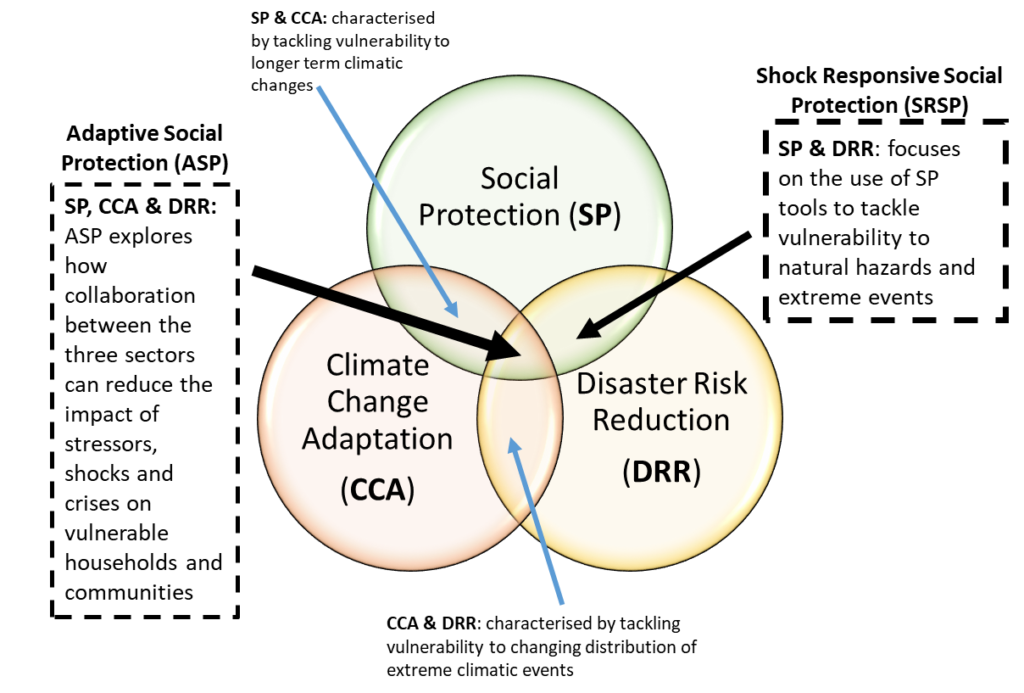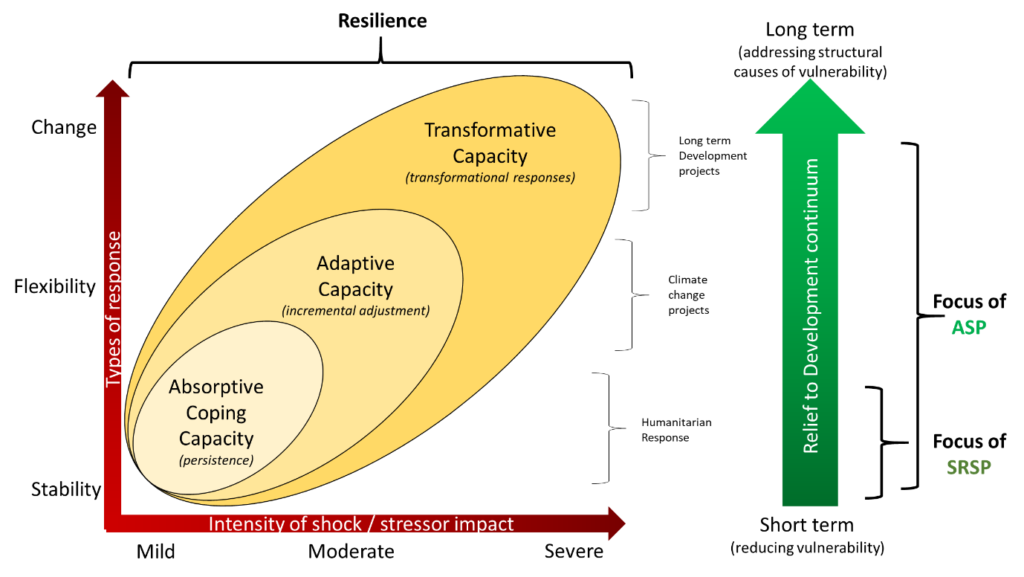The concepts of Shock responsive social protection (SRSP) and Adaptive social protection (ASP) are very similar, and despite much having been written about them in the wider literature, there are no agreed definitions for either. You could then, question whether these two concepts are referring to the same type of programme – title applied depending on what happens to be du jour in a particular country, institution or donor. Or are they in fact two closely related but fundamentally different types of programmes?
Having had the chance to reflect on our own experiences in the field, and immersing ourselves in the literature, we suggest that there are fundamental differences between the two, and it’s helpful to think about them in the context of the following three characteristics (and two handy diagrams…)

- The thematic spaces they engage with: Diagram 1 above shows how the concepts differ in terms of the thematic spaces (represented graphically by bubbles) within which they interact, and highlights the subtle differences in their objectives. Shock responsive social protection typically works closely with actors involved in humanitarian response and focuses on how elements of SP (tools, concepts, techniques, mechanisms, programmatic approaches) can be most effectively mobilised and rapidly expanded in the instance of a shock or a crisis. Adaptive social protection by contrast recognises and responds to the knowledge that climate change will bring additional stressors and shocks to people, sectors and society, from the household and community to national levels. ASP, therefore, takes an integrated approach, building understanding around how collaboration between actors from SP, climate adaptation and disaster risk reduction can provide longer-term solutions to address the underlying causes of vulnerability and help people prepare for the impacts of climate change.

- How they contribute to building resilience1: The conceptualisation of resilience is (currently) understood as resulting from the combination of three interrelated but distinct capacities: (1) absorptive capacity; how households moderate or buffer the impact of a shock, (2) adaptive capacity; adjustments that people undergo in order to continue functioning without major changes in function or structural identity, and (3) transformative capacity – the ability of people to change in response to major structural changes to their context or environment. SRSP at its core is about ensuring the early warning systems, funding, planning and targeting mechanisms exist in order to rapidly scale up the response of social protection mechanisms in times of shock. The idea is to reduce the burden on the humanitarian systems, and (typically) build ownership within governments. Getting this right is important, and it’s been proven that rapid response in the case of shocks, and appropriately scaling up to capture vulnerable populations (as opposed to a focus on poverty) can significantly offset or reduce what would otherwise have been long-term detrimental effects- principally by building the absorptive capacity of the recipients through the transfers of funds during a shock or crisis. The characteristics of an ASP system (which you can read about in this second blog in the series) also include these objectives but builds on them with a longer-term vision for resilience. ASP recognises that SP tools and mechanisms also provide an ongoing opportunity to contribute to fostering households’ adaptive and transformational capacity to climate change (read more here). Initial analysis on ASP programming from 124 programmes in Asia showed that the inclusion of a combination of social protection, disaster risk reduction and climate change objectives in an integrated programme is more likely to foster the adoption of preventive (anticipative) and longer-term adaptive and/or transformational interventions as opposed to short-term responsive measures.
- Where they sit on the continuum of ‘relief’ to ‘development’: The three ovals in diagram 2 highlights how resilience is also increasingly used as a “programmatic bridge” to help along the integration of short-term responsive humanitarian interventions (where SRSP sits) with longer-term development programmes. Understood in a linear way, the framework above suggests that managing for resilience requires directing a system in a way that promotes resistance in a period of small disturbance, adaptation in a time of greater disturbance, and transformability when conditions are becoming unviable or unsustainable. By focusing on the three capacities of resilience (absorptive, adaptive and transformative), we suggest that ASP interventions embrace the whole Relief-to-Development continuum.
And so what? Why does it matter? What does it imply for Donors?
The discussion above demonstrates that SRSP programmes could be considered a sub-set of ASP programmes that focuses on mobilising effective safety net and SP programmes to cushion/offset the negative effects of shocks and disasters on affected households and communities. This is a critical element in building the absorptive component of these households/communities resilience, and as such should be pursued –especially since the literature highlights the overwhelming prevalence of absorptive-type responses (coping strategies) in low-income countries.
However it also highlights that there is value in considering the long game, and how fostering collaboration between social protection, climate change and disaster risk communities of practice can support adaptive and/or longer-term transformative changes. If there is appetite and technical capacity to do so, donors should consider ASP programmes, ensuring in particular that these programmes are effectively building adaptive capacities.
There are certainly many questions that remain unanswered. How do we target vulnerability? How frequently should we update registers and how do we pay for that? How do we measure adaptive capacity, and the ability of SP to deliver on this? These are the types of questions we have been grappling with in our evaluation of the ASPp in the Sahel. Round two has just been funded, and in order to realise the full potential of both SRSP and ASP we need more systematic and rigorous evaluations – watch this space!

